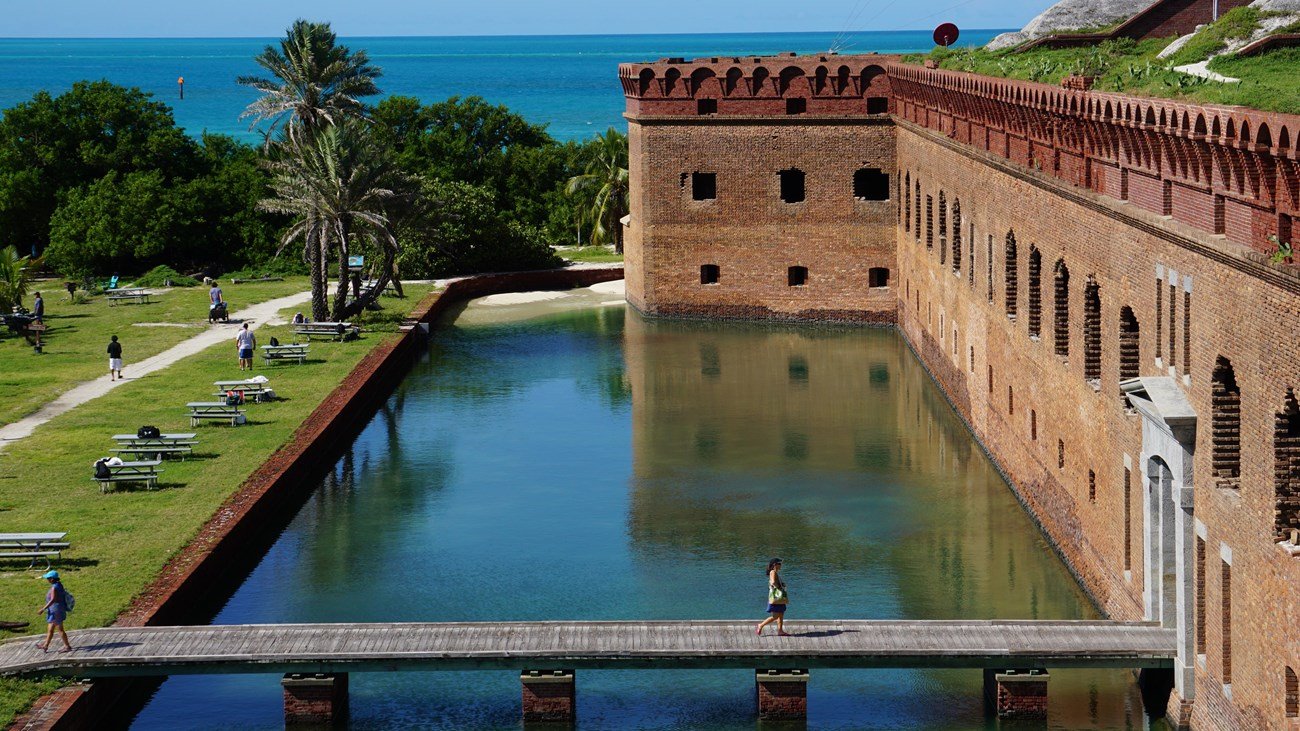Introduction
Dry Tortugas National Park is a hidden gem nestled in the Gulf of Mexico, about 70 miles west of Key West, Florida. This remote paradise is renowned for its crystal-clear waters, vibrant coral reefs, and historical significance. It’s a place where history meets nature, offering visitors an unparalleled experience. But what makes Dry Tortugas so unique and worth visiting? Let’s dive in and explore the wonders of this incredible national park.
History of Dry Tortugas National Park
Dry Tortugas has a rich history that dates back to its discovery by Spanish explorer Juan Ponce de León in 1513. The name “Tortugas” (meaning turtles) was inspired by the abundance of sea turtles in the area. The “Dry” was added later to indicate the lack of fresh water on the islands.
During the Civil War, Fort Jefferson was built on Garden Key, one of the seven islands that make up the Dry Tortugas. This massive coastal fortress, although never fully completed, played a critical role as a Union military prison. Today, the fort stands as a testament to American history and is a key attraction for visitors.
Geography and Location
Dry Tortugas National Park comprises seven small islands: Garden Key, Loggerhead Key, Bush Key, Long Key, Hospital Key, Middle Key, and East Key. Located in the Gulf of Mexico, the park is accessible only by boat or seaplane, making the journey there an adventure in itself. The remoteness of Dry Tortugas contributes to its pristine condition, free from the hustle and bustle of more easily accessible destinations.
Ecosystem and Wildlife
The park is home to an astonishing variety of wildlife. The surrounding waters teem with marine life, including colorful fish, sea turtles, and vibrant coral reefs. Bird enthusiasts will be thrilled by the numerous species that nest and migrate through the area, including the sooty tern and the magnificent frigatebird. On land, you’ll encounter the Cuban brown anole and hermit crabs, adding to the park’s diverse ecosystem.

Coral Reefs and Marine Life
The coral reefs of Dry Tortugas are a major draw for visitors. These underwater gardens are some of the most vibrant and diverse in North America. Snorkelers and divers can explore the reefs, encountering a plethora of marine species like angelfish, parrotfish, and the occasional nurse shark. The reefs are not only beautiful but also crucial for the health of the marine ecosystem.
Historic Fort Jefferson
Fort Jefferson is the centerpiece of Dry Tortugas National Park. Constructed in the 19th century, this massive fortress is one of the largest brick structures in the Western Hemisphere. Its hexagonal design and imposing walls tell stories of a bygone era. Visitors can tour the fort, walking through its historic corridors and imagining life during the Civil War. The views from the top of the fort are breathtaking, offering a panoramic vista of the surrounding waters and islands.
Activities in Dry Tortugas National Park
There’s no shortage of activities to enjoy in Dry Tortugas. Snorkeling and diving are top choices, thanks to the clear waters and abundant marine life. Kayaking around the islands provides a unique perspective, allowing you to explore hidden coves and pristine beaches. For those who enjoy camping, the park offers a unique opportunity to sleep under the stars on Garden Key.
Snorkeling and Diving Spots
The best snorkeling spots include the shallow waters around Garden Key and the coral heads near Loggerhead Key. For diving enthusiasts, Little Africa and the Windjammer Wreck are must-visit sites. Remember to bring your own gear, as rentals are not available on the islands. The underwater visibility is excellent, making it easy to spot a wide array of marine life.
Bird Watching
Dry Tortugas is a bird watcher’s paradise, especially during the spring and fall migrations. The islands serve as a crucial stopover for many migratory birds. Bird watching is particularly rewarding at Garden Key and Bush Key. Bring your binoculars and a bird guide to make the most of your experience. Early morning and late afternoon are the best times for bird watching.
Camping at Dry Tortugas
Camping in Dry Tortugas is a unique experience that offers a chance to truly disconnect and immerse yourself in nature. Facilities are primitive, so you need to bring everything you need, including water, food, and camping gear. Permits are required, and it’s advisable to book well in advance due to limited availability. The clear night skies, free from light pollution, make stargazing an unforgettable part of the camping experience.
Guided Tours and Ranger Programs
The park offers several guided tours and ranger-led programs that enhance your visit. These educational programs cover the history, ecology, and geology of the park. Rangers provide insightful information that brings the park to life, making your visit more enriching. Check the schedule at the visitor center for tour times and availability.
Tips for Visiting Dry Tortugas National Park
- Best time to visit: The best time to visit is during the dry season from November to April. The weather is more predictable, and the seas are calmer.
- What to bring: Essential items include sunscreen, hats, plenty of water, and snacks. Don’t forget your snorkeling gear if you plan to explore the reefs.
- Safety tips: Be aware of the weather conditions and follow park guidelines. There are no lifeguards, so swim with caution and stay within designated areas.
Sustainable Tourism in Dry Tortugas
Conservation is a top priority in Dry Tortugas. The park’s delicate ecosystems require careful management to preserve their natural beauty. Visitors can help by following Leave No Trace principles, such as packing out all trash, not disturbing wildlife, and respecting all park rules. Participating in clean-up efforts and supporting conservation programs also contribute to the park’s sustainability.
Getting to Dry Tortugas National Park
Reaching Dry Tortugas is an adventure. The most common way to get there is by ferry from Key West, which takes about two and a half hours each way. Seaplane services are also available, offering a quicker and more scenic route. Regardless of how you choose to travel, the journey is part of the experience, offering stunning views of the Gulf of Mexico.
Conclusion
Dry Tortugas National Park is a destination that combines natural beauty, rich history, and a sense of adventure. Whether you’re exploring the vibrant coral reefs, touring the historic Fort Jefferson, or simply soaking up the sun on a secluded beach, there’s something for everyone. This remote paradise is well worth the effort to visit, providing an unforgettable experience that will stay with you long after you leave.
FAQs
How do I get to Dry Tortugas National Park? You can reach Dry Tortugas National Park by ferry or seaplane from Key West, Florida. Reservations are recommended as both options can fill up quickly.
What are the best activities to do in the park? Top activities include snorkeling, diving, bird watching, touring Fort Jefferson, and camping on Garden Key.
Is camping allowed in Dry Tortugas? Yes, camping is allowed on Garden Key. However, facilities are primitive, and you need to bring all your supplies, including water and food.
What wildlife can I expect to see? Expect to see a variety of marine life, including sea turtles, colorful fish, and coral reefs. Bird watchers can spot numerous migratory species, and on land, you may see hermit crabs and lizards.
How can I help preserve Dry Tortugas National Park? You can help by following Leave No Trace principles, participating in clean-up efforts, and supporting conservation programs. Be respectful of the wildlife and natural surroundings, ensuring they remain pristine for future visitors.




